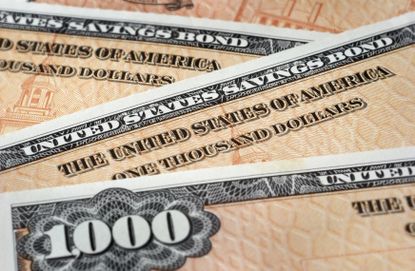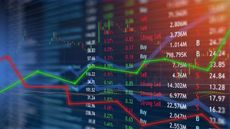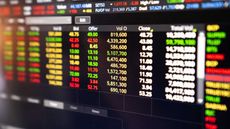The Current I-Bond Rate Until November Is Mildly Attractive. Here's Why.
I-Bonds issued May 1 through October 31, 2024 will have the same rate.


Though the potential return of U.S. Treasury I-bonds as a long-term investment is no sure thing, Americans have voted for them with their wallets: Billions of dollars of these formerly obscure securities were sold in 2022, including in a last-minute rush at the end of October of that year to capture the 9.62% rate. The demand was so robust it knocked the TreasuryDirect website, the only place these bonds can be bought, offline at times.
Of course, you can get them just fine today, now that the current I-bond rate is down. The rate is set every six months, in May and November, and is made up of two components. One is based on the government’s consumer price index (CPI), and given that inflation has slowed since 2022, the rate for I-bonds has also slowed, but it is still an attractive prospect in certain lights.
The other component of the I-bond return is a fixed rate — picked by the Treasury Department without further explanation — that will only apply to bonds issued May 1 to Oct. 31, 2024. And that fixed rate is, well, fixed — unlike the variable inflation component, whatever the fixed rate was when the bond was issued, you’ll get paid that for as long as you hold the bond (and the term is 30 years).
The current I-bond rate, valid for bonds issued May 1 through Oct. 31, 2024, is 4.28%. That includes a fixed rate of 1.30%. To put that in context, the best high-yield savings accounts and the best CD rates are giving returns over 5%. Halfway into 2024, the S&P 500 has had a year-to-date return of 16.84%, making analysts' top S&P 500 stocks to buy an attractive option.

Sign up for Kiplinger’s Free E-Newsletters
Profit and prosper with the best of expert advice on investing, taxes, retirement, personal finance and more - straight to your e-mail.
Profit and prosper with the best of expert advice - straight to your e-mail.
So, 4.28% is not all that much to write home about. But I-bonds are still on the table because they offer stability and a guarantee.
What makes the current I-bond rate attractive
Consider the fixed rate of an I-bond, which is an important component of what an I-bond is. That rate is fixed for as long as you hold the bond, which has a term of 30 years. So, if you purchase an I-bond between now and November, you'll always get a return of at least 1.30%. Again, that's not a huge return, but it's a guarantee — and considering that people's most popular investment is cash, 1.30% for 30 years is a much higher return than you might get with cash just sitting in a checking account.
So here’s an interesting twist, and possibly a consolation prize for anyone who didn’t manage to get I-bonds when they were paying a higher yield in 2022: those bonds paid a fixed rate of zero.
While it might seem unimaginable now as the Federal Reserve has continued to hold short-term interest rates high and other rates, including mortgages, have climbed to levels not seen in decades, zero inflation or deflation could return. And if that happens, those who hold bonds bought between now and Oct. 31 will continue to receive 1.30% interest, while holders of the 9.62% bonds will receive — at least so long as inflation is flat or negative — nothing.
And, again, if 1.30% seems laughably low, remember that only a few years ago, savers looking to certificates of deposit, savings accounts and other low-risk investments would have been darn happy with that.
What to do with your I-bonds
First, I-bonds must be held for at least a year. There is no way to cash them before this period. And second, if you redeem them before five years from the time they were issued, the last three months of interest is lost.
Another key note: There’s a limit of $10,000 a year to how much you can buy in I-bonds. But, you can also get $5,000 in I-bonds if you use your tax return to buy them, and those bonds will be issued in cash.
In case you haven't noticed, I-bonds are a little complicated. Ultimately, though, for the moment, they present a reasonably attractive long-term option for safe cash growth.
Related Content

To continue reading this article
please register for free
This is different from signing in to your print subscription
Why am I seeing this? Find out more here
Get Kiplinger Today newsletter — free
Profit and prosper with the best of Kiplinger's advice on investing, taxes, retirement, personal finance and much more. Delivered daily. Enter your email in the box and click Sign Me Up.

In his former role as Senior Online Editor, David edited and wrote a wide range of content for Kiplinger.com. With more than 20 years of experience with Kiplinger, David worked on numerous Kiplinger publications, including The Kiplinger Letter and Kiplinger’s Personal Finance magazine. He co-hosted Your Money's Worth, Kiplinger's podcast and helped develop the Economic Forecasts feature.
- Alexandra SvokosSenior Digital Editor
-
 Costco Raises Membership Fees For First Time Since 2017
Costco Raises Membership Fees For First Time Since 2017Costco is raising its membership prices for the first time in nearly seven years. Here’s what you need to know.
By Joey Solitro Published
-
 PepsiCo Stock Falls On Q2 Revenue Miss, Revised Outlook: What to Know
PepsiCo Stock Falls On Q2 Revenue Miss, Revised Outlook: What to KnowPepsiCo stock is trading lower after mixed second-quarter results and revised outlook. Here’s what you need to know.
By Joey Solitro Published
-
 Costco Raises Membership Fees For First Time Since 2017
Costco Raises Membership Fees For First Time Since 2017Costco is raising its membership prices for the first time in nearly seven years. Here’s what you need to know.
By Joey Solitro Published
-
 PepsiCo Stock Falls On Q2 Revenue Miss, Revised Outlook: What to Know
PepsiCo Stock Falls On Q2 Revenue Miss, Revised Outlook: What to KnowPepsiCo stock is trading lower after mixed second-quarter results and revised outlook. Here’s what you need to know.
By Joey Solitro Published
-
 Try Swimply, the Airbnb of Pools, and Rent a Luxury Pool This Summer
Try Swimply, the Airbnb of Pools, and Rent a Luxury Pool This SummerWith Swimply, you can live it up at a luxury pool while escaping the heat and going for a swim.
By Erin Bendig Published
-
 Stock Market Today: Markets Surge on Dovish Remarks From Powell
Stock Market Today: Markets Surge on Dovish Remarks From PowellThe S&P 500 topped 5,600 for the first time ever, boosted by mega-cap tech stocks.
By Dan Burrows Published
-
 Best Closed-End Funds (CEFs) to Buy Now
Best Closed-End Funds (CEFs) to Buy NowThe best closed-end funds will significantly boost your portfolio income and allow you to buy their underlying stocks and bonds at a discount.
By Charles Lewis Sizemore, CFA Published
-
 Stock Market Today: Markets Hover Near Record Highs on Powell Testimony
Stock Market Today: Markets Hover Near Record Highs on Powell TestimonyStocks were little changed on light volume as the Fed chief testified before Congress.
By Dan Burrows Published
-
 Stock Market Today: Markets Set Fresh Highs as CPI, Earnings Loom
Stock Market Today: Markets Set Fresh Highs as CPI, Earnings LoomStocks wavered on light volume ahead of a busy week for economic news and corporate earnings.
By Dan Burrows Published
-
 10 Money-Saving Hacks for Amazon Shoppers
10 Money-Saving Hacks for Amazon ShoppersThere are many money-saving hacks for Amazon shoppers if you know how to use them.
By Kathryn Pomroy Published